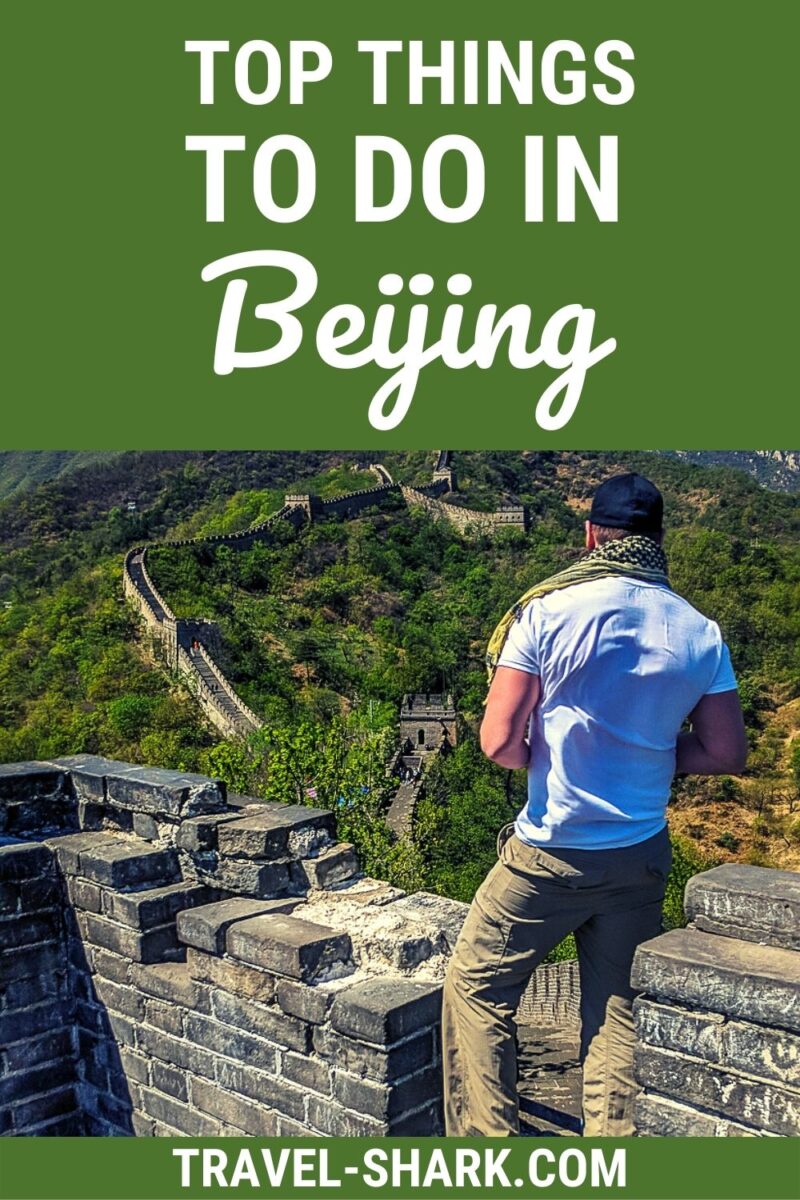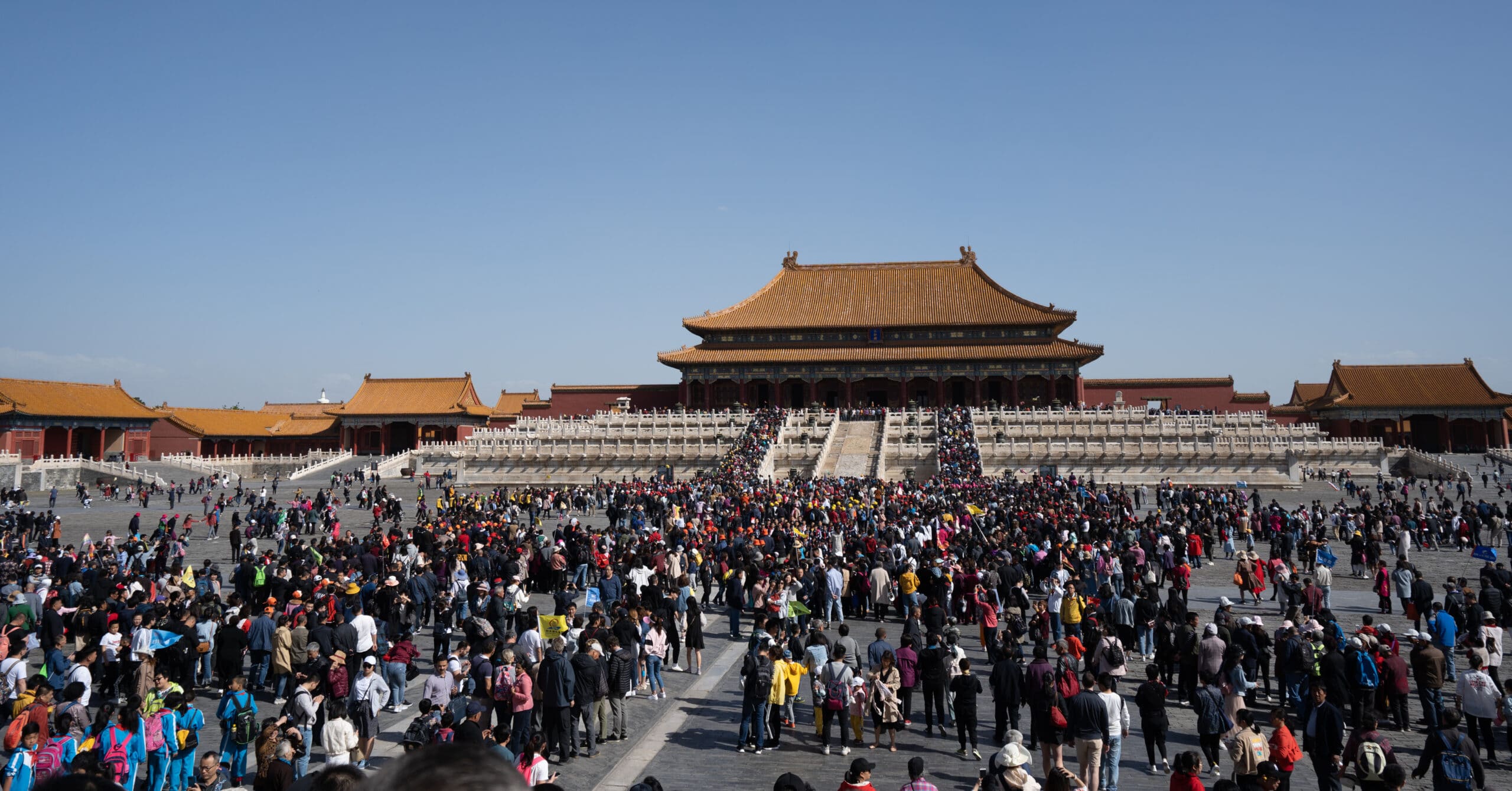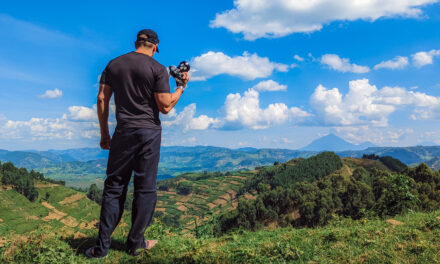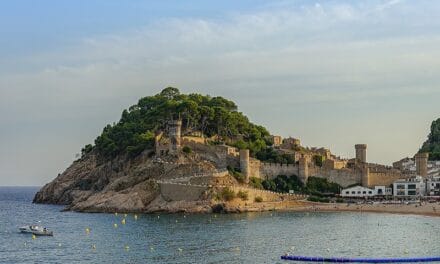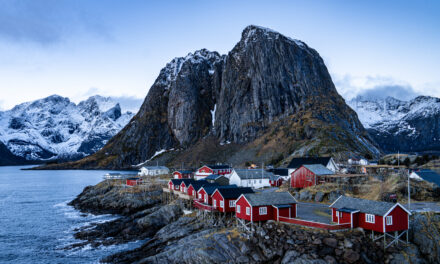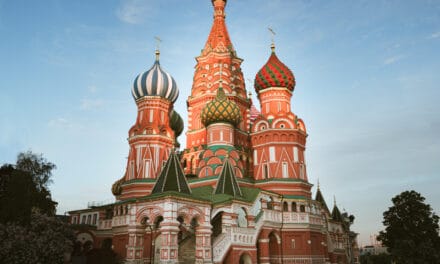Table of Contents
What are the top things to do in Beijing?
Beijing is once again open for business, and it is a city rich in history and culture. Unfortunately, much of that culture is being bulldozed and rebuilt by the Chinese progress machine so be sure to get there before it’s too late!
Am I exaggerating? Maybe a little. Beijing is massive but there is a large modernization push that is leaving the many traditional streets as little more than a memory. I saw many of the new modern areas and the only way I can really describe them is… cement. Everything felt like cement.
So you’re there before progress takes over. What are the top things to see in Beijing? How much time do you need? I spent five days in the city, and while you can squeeze things into less, I’m going to advise against that here. Anything less than four will require some major sacrifices. I’m talking Great Wall of China major. And that’s something you do not want to skip.
China Covid Restrictions 2023
China may be open for travel once again, but COVID testing for visitors remains in place.
All China-bound travelers will need to take a nucleic acid test or Antigen Rapid Test (ART, including the ART home testing kit) for COVID-19 within 48 hours before boarding, and can only travel to China when your test result is negative.
What to do? Or not do.
Beijing Zoo
This is on top of my list because I don’t want you to miss what I’m going to say. SKIP THE ZOO. Skip all Chinese zoos. Don’t go here. Don’t go to any others. Please, just don’t. I skipped it and you should too.
Why not? I’m not fond of zoos in general, but some do serve a purpose such as conservation or rehabilitation. Chinese zoos, however, only seem to serve themselves.
The conditions in Chinese Zoos are absolutely horrendous. Were this zoo in any Western country, be it in Europe or North America, it would be shut down. If you have any doubts just Google “Beijing Zoo Conditions“ and you’ll find a litany of scathing articles and reviews.
Now, what to actually do in Beijing.
The Great Wall of China
Can you think of anything more closely associated with China?
While far from walking distance, some sections of the wall such as Mutianyu are within the Beijing city limits. This fully restored section affords you breathtaking views and fewer tourists than some of the other restored sections. This stretch is also packed full of 22 watchtowers over 3.4 miles (5.5km) for you to explore.
The walk up to the wall from the ticket gate is somewhat long and almost entirely up stone steps so if that’s not for you, a cable car will bring you to the top and drop you off at Watchtower #14.
You can ride the cable car down as well or you can take the toboggan slide down from Watchtower #6 which is what I did.
The toboggan is fun but if you want to go fast, be sure to give the people ahead of you plenty of time. I caught up to the earlier group in spite of a several-minute head start. I was cookin’ though and got yelled at a few times to slow down.
Watchtower #6 also has a small chair lift that will get you up or down if neither of the other options appeal to you.
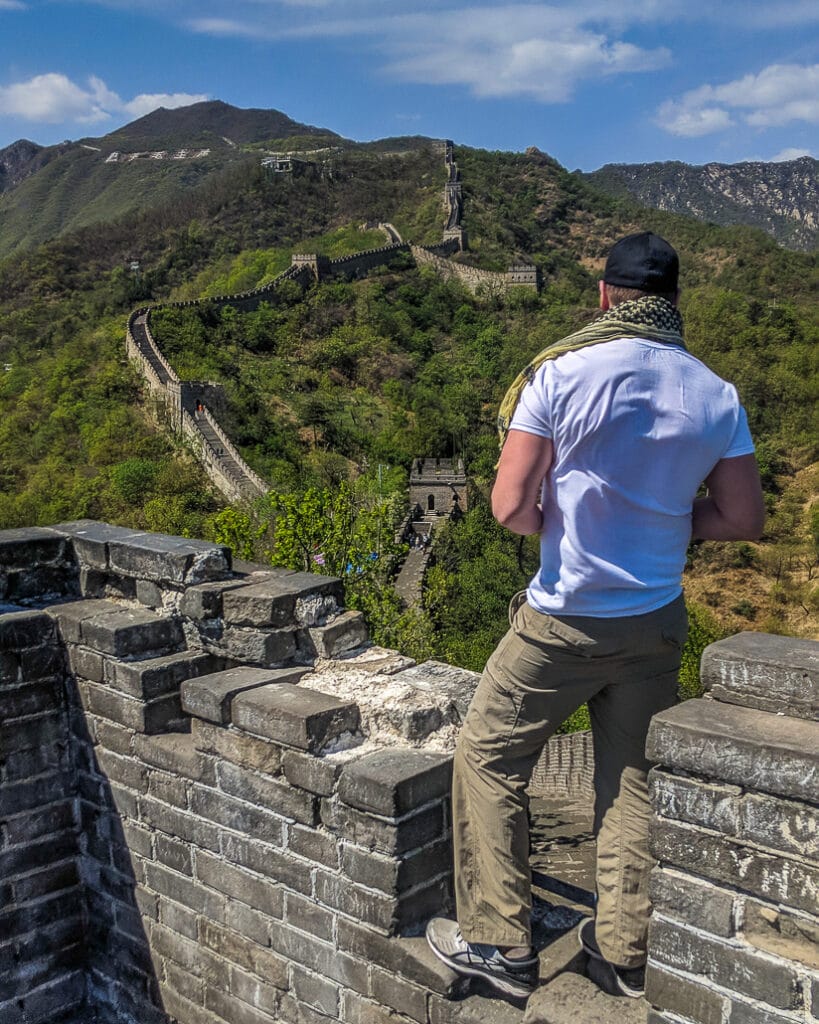
Getting There
Located 40 miles (65km) north of the Beijing city center, Mutianyu can be reached with varying degrees of difficulty. First, you’ll need to get to the Dongzhimen Bus Station in Beijing where you’ll hop on either bus No. 916 Express or the 916 to Huairou North Avenue.
All recommendations I got in the city were to take the Express with a transfer in the Huairou District. Then, transfer to bus lines h23, h24, h35, or h36 to the Mutianyu Roundabout. From there it’s a short walk to the ticket office.
I scouted it out in person and it’s less complicated than it appears while reading it here.
The easiest way, however, is to hire a car service through wherever you’re staying which is what I did.
The aforementioned varying degrees of difficulty that I mentioned came due to the tourist traffic. While I was in Beijing it was their Labor Day (May 1st). Due to the holiday, there were extremely long lines waiting for any bus going to the wall.
My guide from when I camped on the Great Wall explained to me that whenever there is a holiday in China, there is a massive influx of people visiting Beijing and the surrounding area.
According to him, this tourist influx is a very uniquely Chinese thing because they love their country so much. I’d like to invite him to visit the Jersey Shore on 4th of July weekend.
Off the Beaten Path
Should you want something a little more off the beaten path, perhaps you’d like to experience camping and hiking on an unrestored section of The Great Wall. You can find details of my experience here: Camping on The Great Wall of China.
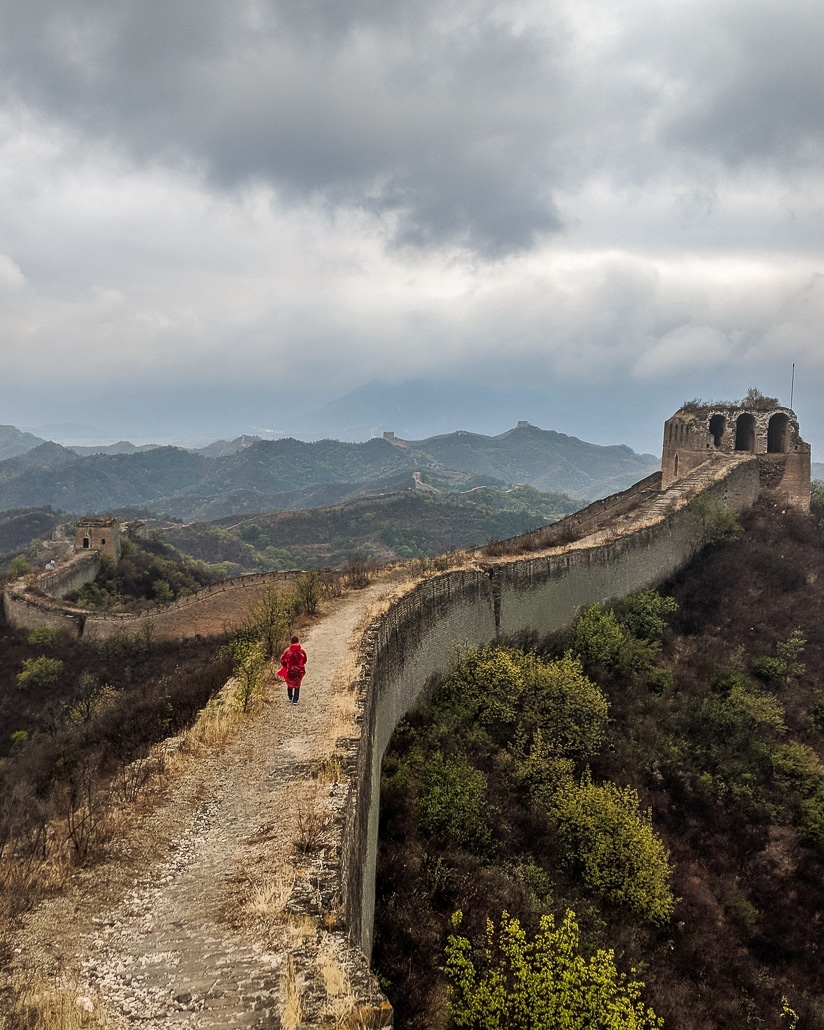
Cost and Tours
My private tour included the restored section, Great Wall Mutianyu, Forbidden City, a jade museum, a traditional tea ceremony, and full transportation via private car.
By saving me a long wait for the bus, it allowed me to fit more into my day. Had I taken the bus I probably would have been forced to skip the jade museum and tea ceremony.
This full tour package cost me CYN 970 or about $137.00 Was this the cheapest option? No. But due to the local holiday, my plans got changed and I had to book last minute. CYN 850 of that was the tour fee for the company.
My toboggan ride down from the top of the wall was not included in the tour price and cost CNY 60 (about $8.60). Cable cars are separate as well.
Admission fees for tickets alone are Adults: CNY 40, Seniors: CNY 20, and Children between 3.9 and 4.6 feet: CNY 20. Yes, children are charged by their height.
I’ll note that the Badaling section of the Great Wall which is just as well preserved offers direct public transport without the transfer required by Mutianyu. I didn’t go here but I did hear that it’s usually far more crowded.
Forbidden City
The largest Imperial Palace in the world, The Forbidden City was home to 24 emperors and their households for almost 500 years. This well-preserved UNESCO site consists of 980 buildings across 180 acres and offers a veiled look into the Emperor’s life.
I say veiled because as opulent as this may seem, the life of the Emperor looks like it was pretty miserable and controlled, in my opinion, at least.
The buildings here aren’t just beautiful, they’re also restored and well-maintained.
Beijing went through a massive restoration push before the 2008 Summer Olympics with Forbidden City receiving a lot of work. It happened again before the 2022 Winter Olympics, but in what I’ve heard to be other areas.
I really enjoyed seeing this piece of history but it wasn’t the most pleasurable experience as being Labor Day, there were eight billion (no exaggeration!) people here all trying to force their way through.
Let me tell you, out of every country I’ve been to, the Chinese were by far the pushiest with zero sense of personal space. Lines didn’t exist while I was there.
Eventually, after receiving a hard elbow in the ribs from someone trying to dig past me, I locked my arms and bulldozed my way through since I was so much bigger than everyone.
As nice as Forbidden City was, I felt a little disappointed by the route tourists were allowed to take. You enter from the front, walk straight down the middle, and out the back. None of the side areas were open.
You could see the main draws like the Emperor’s Residence, but the hundreds of smaller buildings off to the sides were off-limits.
Tickets can be bought on-site for CNY 60 ($8.58) during the high season of April – October and CNY 40 ($5.80) during the low season. Buying these tickets on your own will save you a few dollars over going through a tour agency but once inside you’ll be on your own.
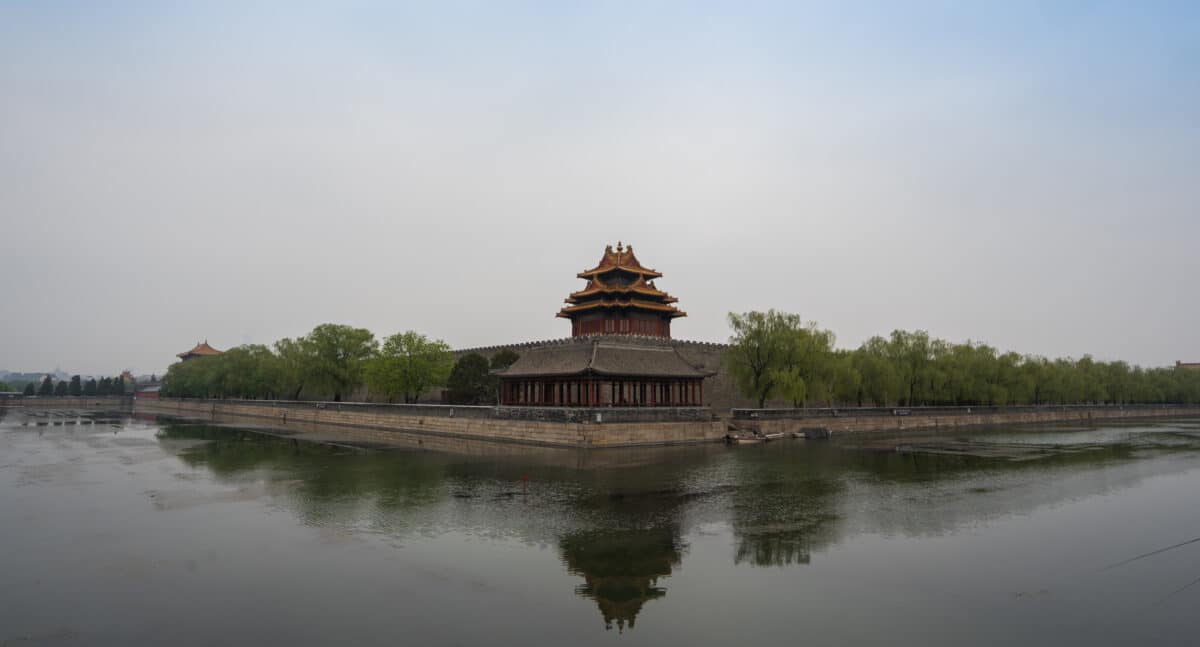
Jingshan Park
The city is too big. You can’t possibly see it all! Or can you? Well, it depends on what you mean by seeing it all and that’s where Jingshan Park comes in on your list of things to do in Beijing.
This hill is located in the dead center of what was once the historical Beijing. I mean literal dead center as in there’s a bronze marker at the top pavilion that tells you the center point.
When combined with the markers on the 4 other peaks, (each with an elaborate pavilion of their own) you’re able to draw what was the axis of central Beijing.
This hill, being the only one in Beijing, will afford you unobstructed views of the city. Just be prepared for the stairs. Lots of stairs.
How is this the only hill? It does seem a bit out of place. Well, that’s because the entire hill is artificial. It was built with the soil excavated while digging the canals and moats that circle the Forbidden City. All of which was moved by hand.
Pretty impressive when you consider that it’s 150 feet high.
You can see just how wide the moat is in the above picture.
Located directly to the north of the Forbidden City, entry to the park is free and well worth a trip to the top of the hill. Unfortunately, the smog may prevent you from seeing everything, but you get the idea.
Should you decide to go, there is a vending machine at the top that is filled with, “Mystery Boxes.” Someone please buy one and let me know what was inside! I wanted to purchase one but the machine wasn’t working at the time.
You’ll need Alipay to purchase a box. It’s basically China’s version of PayPal. I’ll talk more about that below.
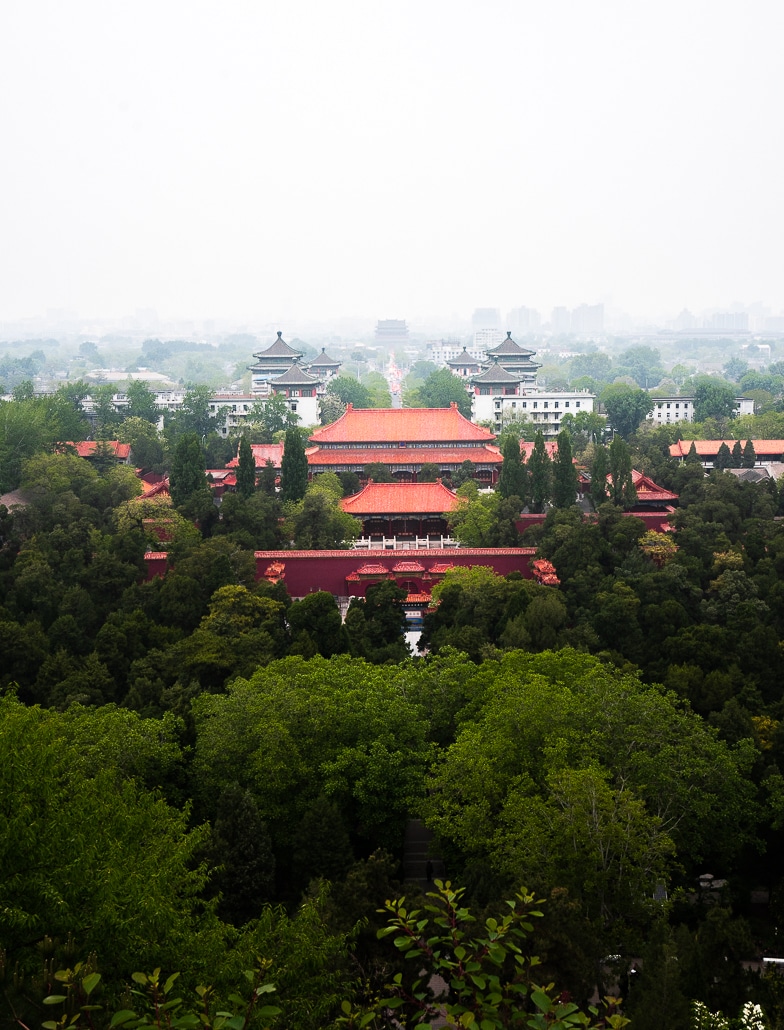
Tiananmen Square
This iconic square located inside the heart of Beijing has played home to numerous political events and protests including the 1989 Tiananmen Square protests. These then gave birth to what is known as the ’89 Democracy Movement.
Unfortunately, these protests ended badly when the Chinese government forcibly suppressed them by declaring martial law and sending the military in to occupy key sections of Beijing. Tragically, armed troops and tanks fired into the crowd of protesters to disperse them.
If you haven’t heard of these protests then perhaps you’ve heard of Tank Man. He was the brave protester who stood down a column of tanks that was trying to exit the square.
The square contains the Monument to the People’s Heroes, the Great Hall of the People, the National Museum of China, and the Mausoleum of Mao Zedong, and is situated to the immediate south of the Forbidden City. This allows you easy access to several of Beijing’s better-known sites.
There is also a flag-raising and lowering ceremony every day that many locals and tourists alike go to watch. You can catch these at sunrise and sunset.
Entrance to the square is free but be aware that being such a political location, the government occasionally closes it without notice. While I was in Beijing it was closed on my last day in preparation for a military parade to be held for the Chinese Labor Day holiday.
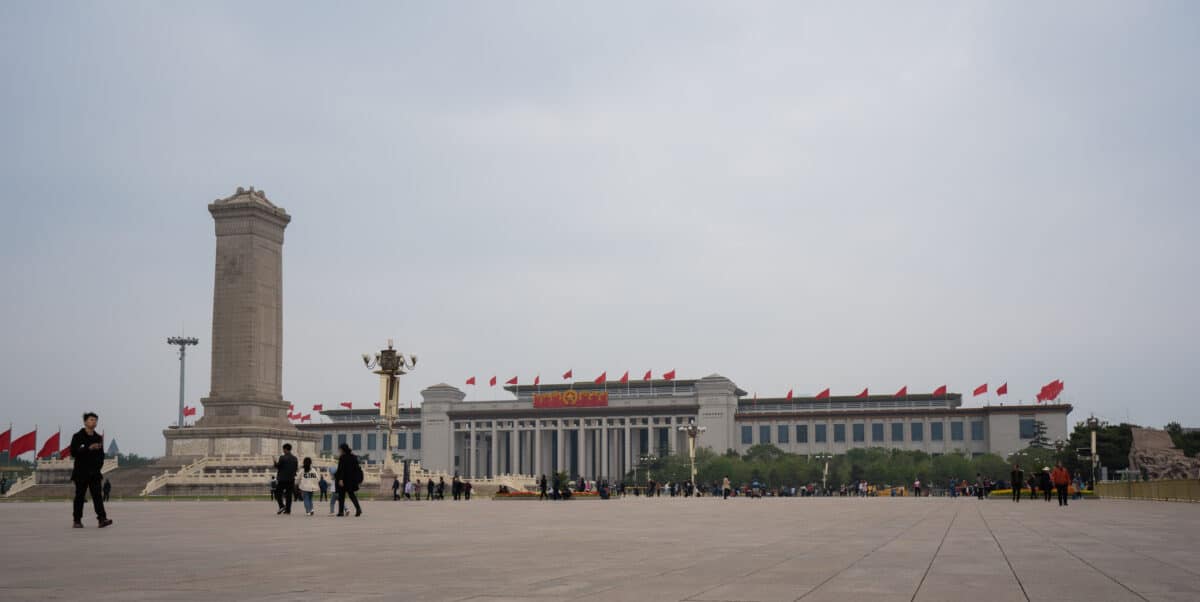
National Museum of China
Located on the eastern edge of Tiananmen Square, the National Museum of China is one of the largest museums in the world with a permanent display of over 1,050,000 items.
Established in 2003 by combining two older museums, it primarily covers Chinese history from the Yuanmou Man of 1.7 million years ago to the end of the Qing Dynasty.
There are some more modern exhibits leading all the way up to the social unrest of 1989 but I didn’t view them. Remember, the museum is run by a government agency so I have my doubts as to how accurate anything regarding the social unrest may be.
To save you the forty-plus minutes I spent trying to figure out how to get inside, the section facing Tiananmen Square is actually the exit. The entrance is around the left side of the building but first, you’ll need a ticket.
The ticket booth is a small, free-standing building that’s set far enough away from the entrance that you might mistake it for something else. If you are facing the museum from Tiananmen Square, it is left and in from the corner. You may need to walk into the area to spot it amongst the plants.
Another confusing part is you’ll probably see everyone scanning QR codes and then getting in a line. You can ignore them.
I never figured out what the codes were for as everything was in Chinese, but if they have anything to do with admission, it’s for Chinese citizens only. All you need is the ticket booth.
Even though you need a ticket, admission is still free of charge. The ticket is mostly so they can have another reason to check your passport. You’ll show your passport again along with your ticket before being searched at the entrance.
Temple of Heaven
Located in the Chongwen District of Beijing, the Temple of Heaven is the largest of the still-existing Chinese sacrificial sites. It is where emperors of the Ming and Qing dynasties held the Heaven Worship ceremony.
While there are several, the most well-known building in the complex is the Hall of Prayer for Good Harvests. This massive building is beautiful but don’t neglect the others as they are quite impressive as well.
The atmosphere here was a lot more subdued (far fewer tourists) than the Forbidden City. I also found this to be the more awe-inspiring construction. You really need to see it in person to realize just how big it is.
The picture below doesn’t do it justice as the people on the stairs give a false sense of proportion. They’re actually standing quite far away.
Cost varies as there are several different types of tickets depending on what you want to do and see. CNY 15 will get you into the complex during high season (Apr. – Oct.) and low (Nov. – Mar.) will cost you CNY 10.
Annoyingly, these tickets do not include entrance to the Hall of Prayer for Good Harvests, Circular Mound Altar, and Echo Wall. You will need to purchase a second ticket which costs CNY 20 year-round. No, you can’t buy just the temple ticket so it’s best to get the combined ticket for CNY 34 (high season) or CNY 28 (low season) and save yourself any hassle later.
Do you need to buy the combined ticket? No, but between you and me, without the combined ticket, you’re only purchasing access to a large community park. If you’re only visiting, you’ll be there for the buildings.

Summer Palace
The Summer Palace is the largest, and best-preserved royal complex in all of China. This collection of gardens, lakes, and palaces was once the summer retreat of the Emperor during the Qing Dynasty. Along with the Great Wall, it is considered to be one of China’s must-sees. The instant you arrive you’ll understand why the emperor went here to escape the bustle of the city.
Unfortunately, it gets very crowded. Due to this, I didn’t stay nearly as long as I could have. You could easily spend half a day here but plan for around three hours if you’re not in a hurry.
Again, it was “holiday” crowded like with Forbidden City when I went so I was out in under two. This was my last day in Beijing and I was so over the crowds that I was gone before seeing everything here.
Getting to Summer Palace is easier than visiting the Great Wall but it isn’t within walking distance from the city center. You’re going to need to hop on the subway, bus, or take a 35-minute cab ride. I took a cab and trying to explain where I wanted to go took some effort. I don’t know if the driver was messing with me but even pointing on a map wasn’t enough.
Avoid showing up at the West Gate as I did. This gets you into the park on the wrong side of the lake.
Tickets for admittance are broken up by the different park sections but there is a combo ticket that will get you into everything. I’d suggest the combo as it will save you some money. The April – October High Season combo will cost you CNY 60 while Low Season costs CNY 50.
Ming Dynasty Tombs
Collectively known as the Thirteen Tombs of the Ming Dynasty, this is the best preserved ancient mausoleum site in China.
The Ming tombs are a collection of mausoleums built by the emperors of the Ming dynasty. Here you’ll find the remains of thirteen different emperors, whose reigns spanned 230 years.
The tombs aren’t located in Beijing City so you will need to do a little driving. A taxi can take you the 31 miles (48km) in a little less than an hour.
At the moment, only three tombs, the Changling Tomb, Dingling Tomb, and Zhaoling Tomb, along with the Sacred Way are open to the public. If this isn’t enough for you to make the trip, something many people like doing is combining the tombs with a visit to Badaling Great Wall. You can book a day tour that includes transportation and both sites for as little as $26.
I didn’t make it to these.
Rickshaws
Usually referred to as Tuk-Tuks in other countries, these are two or three-wheeled passenger carts that are pulled by hand, pedal power, or are motorized. They’re everywhere and you should absolutely go for a ride in one. Preferable one of each type as they’re all a different experience.
They’ll take you pretty much anywhere within reason and are cheaper than a cab. The manual is a short ride, pedal power will get you a few blocks, and motorized can take you on something closer to a regular taxi. I once took one of these for around forty miles in Thailand after getting stuck at a floating market.
Motorized is my favorite because they’ll take you through some very old side roads that cars often can’t fit down so you’ll see more of the city.
These can be sketchy so don’t expect anything romantic or relaxing. One that I rode was literally a scooter that the guy built a scrap metal box around and threw two old seats from a car in.
Another, looking to save some time pulled a U-turn and drove down the wrong side of a highway. It was quite nerve-wracking as there were cars on both sides of us. I’m still astonished by the fact that I didn’t see a single accident while in Beijing.
Prices are very negotiable so remember to haggle. They will usually highball you so pay attention.
Generally, rickshaws are easier than a cab. In spite of numerous attempts, I only took three cab rides in Beijing. This isn’t due to a lack of cabs, but rather because it seems like they don’t want to deal with foreigners. You’ll flag them down and they’ll drive off as soon as they see you’re not Chinese. I had a cab stop, look at me, then drive 25 feet up the road and pick up someone Chinese.
Taxis ordered by a hotel would be the exception.
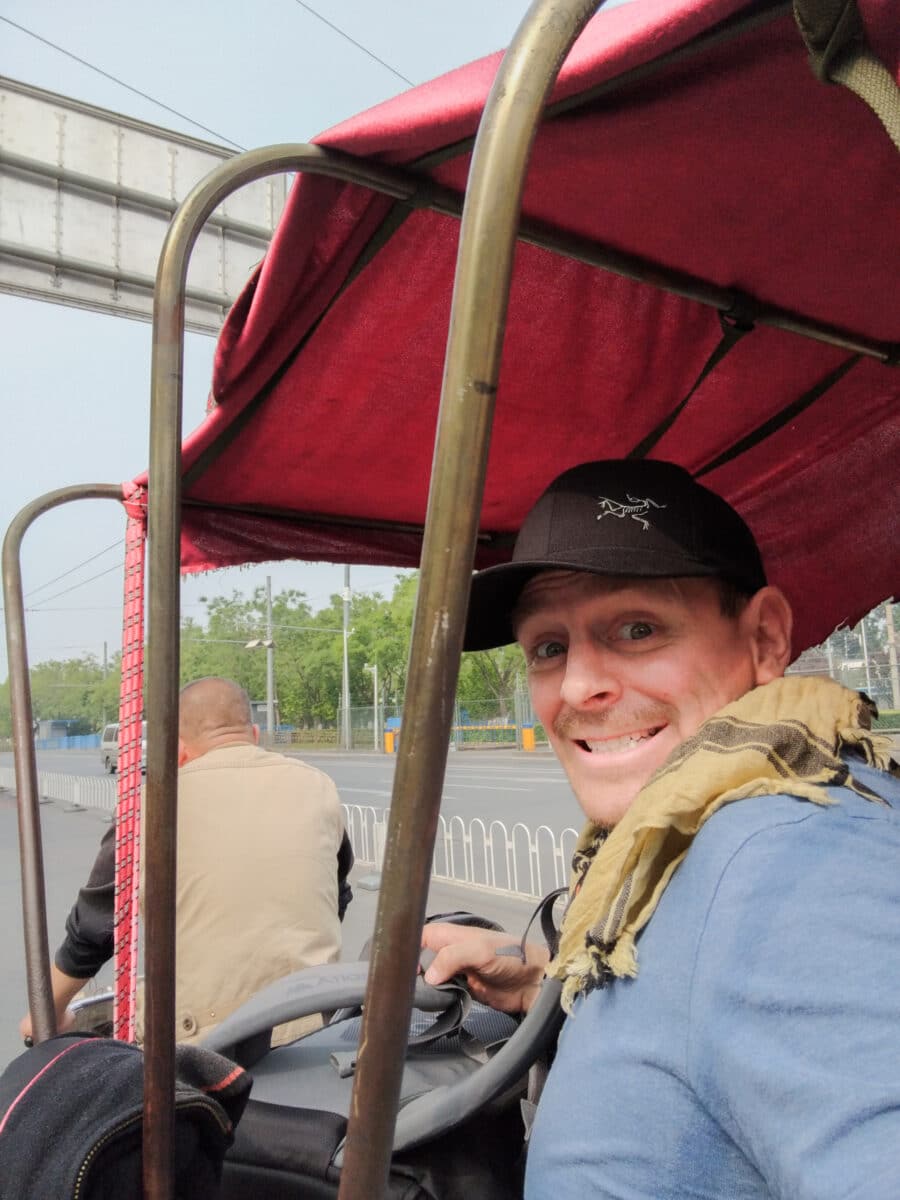
The Food – A Cooking Class
You can’t possibly go to China without having some Chinese food. Though of course, over there they just call it, food. Zing!
Just know that authentic Chinese food is different than what you’ll normally find in America but different in a good and bad way. It’s spicier and avoiding MSG can be difficult but not impossible. Don’t want any MSG or Spices? Try some scorpions on a stick! They’re so fresh that as I walked down the street market, many were still moving.
If you’ve never used chopsticks, get a little practice before you go. While some of the touristy restaurants will have Western utensils, most places won’t.
There’s also a chance that nobody knows what’s in the dish. Apparently, Americans are considered weird for wanting to know what they’re eating. I’d avoid this. I want no part of mystery meat in a country that has no problem eating cats or dogs. No, I’m not stereotyping. It’s a very real thing there. There’s even a dog meat festival.
Want to be absolutely sure of what you’re eating? Take a cooking class! I didn’t do it myself, but I heard learning to make dumplings is fun.
Not hungry? Perhaps try attending a tea tasting. I found this to be pleasant and relaxing.
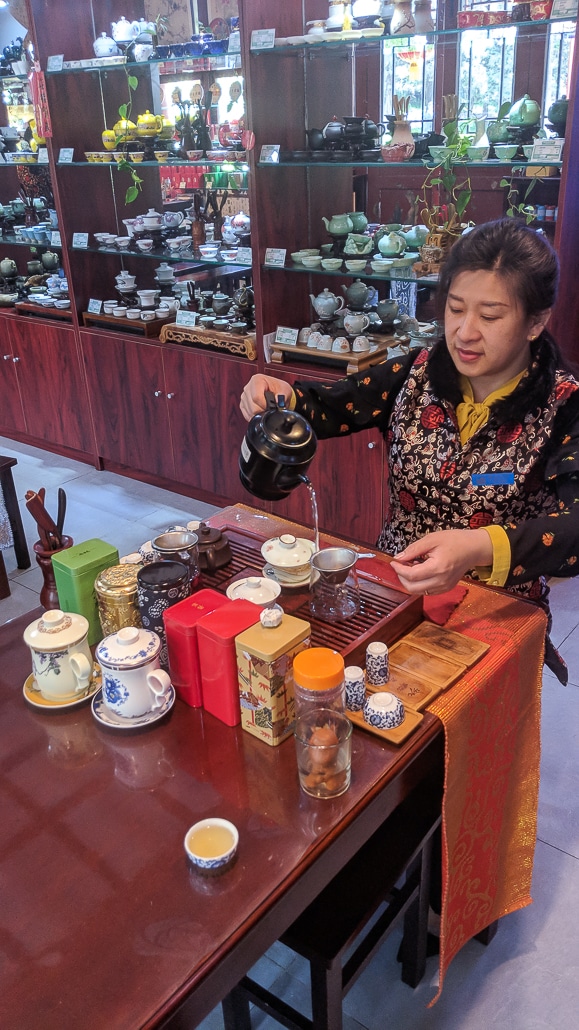
General Advice
When compared to all of the other countries I’ve been to, China is… different. So to help deal with that, here are a few things I think would be important for you to know before you go.
Haggle
Haggle for everything other than prices on a menu and entrance tickets. Some of the more commercial tourist shops also have prices that are pretty set in stone but it’s worth a try. This, along with Egypt was the most haggle-heavy country I’ve been to.
Most places are always willing to come down, sometimes quite drastically. If you’re shopping, just expressing slight interest before walking away will usually be enough to get the merchant to start shouting lower prices at you.
Count your change
We’re all guilty of not counting our change at some point, but when’s the last time you were actually given incorrect change? I can’t even remember. Until… you guessed it. Along came China.
I had two times when girls working a ticket booth tried shorting me on my change. The instant I started to say something, the rest of my money was always sitting on the desk in a separate pile as if they simply forgot to give it to me all at once. No. I watched you count it out from the drawer and then try to skim a few Yuan for yourself. Crook.
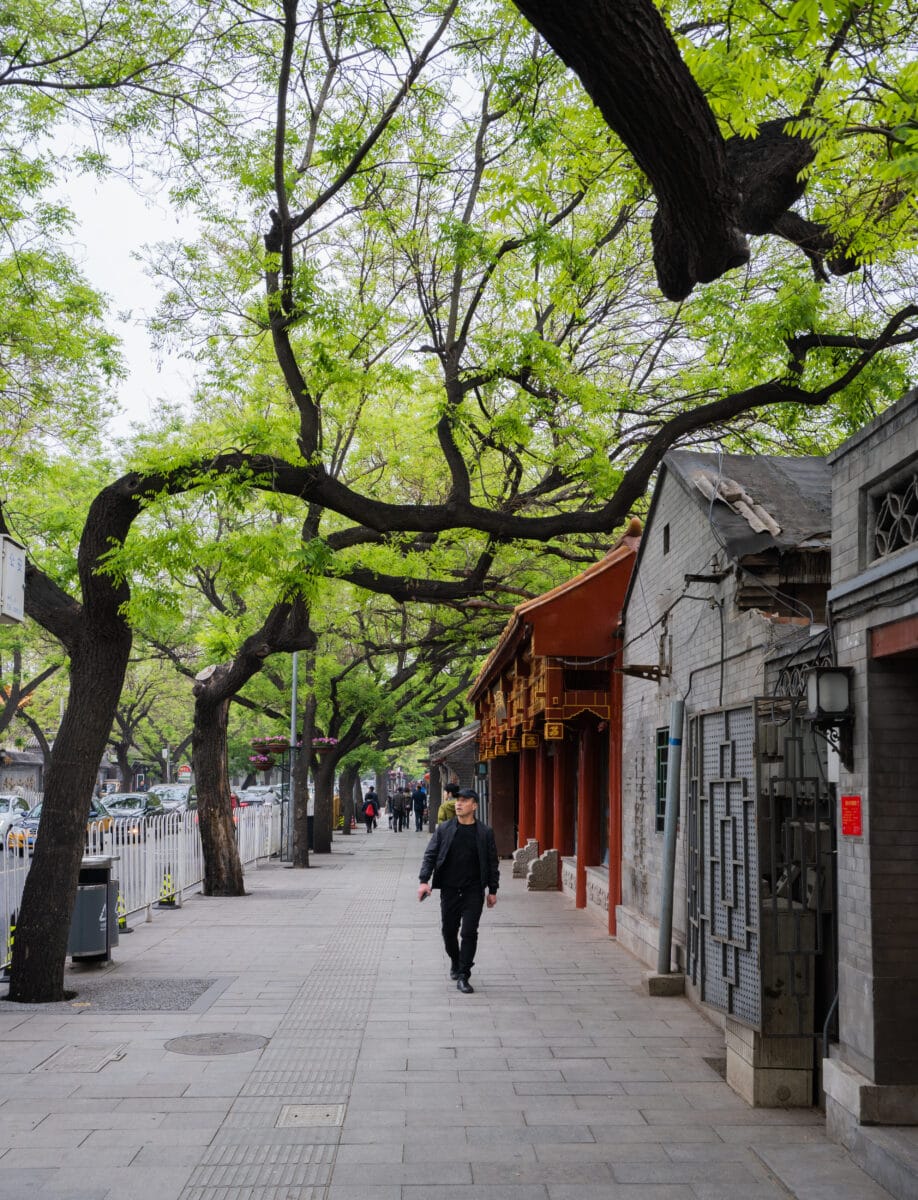
Pay in Yuan but convert all prices to check them.
In my opinion, you should always be doing this anyway, but China is the only place I’ve been where it became necessary. On several occasions, I was quoted exorbitantly high prices and when I questioned them, the price was suddenly 1/5th of what they said.
$10 for a cheap pen with a panda on it will stand out as a red flag, but if you’ve just gotten to the country, CNY 70 might not spark any alarms. Again, like with the skimming, China is the only country where I’ve had this happen.
I use the XE Currency App on my phone. Whenever I travel I add it to my home screen. It’s quick and easy to use.
Cash Withdrawals
Either bring it with you from the US or withdraw a decent amount of money all in one go. While you can use a credit card in places like ticket booths and hotels, by and large, credit is not accepted. Or at least not Master Card, Visa, or American Express.
I tried buying soda at a McDonald’s and they wouldn’t accept credit in spite of it being visibly listed. By making one large withdrawal and hiding it among your belongings you’ll be able to avoid multiple steep transaction fees which can add up quite fast. Once you’re outside of the major cities don’t even bother asking. Cash only.
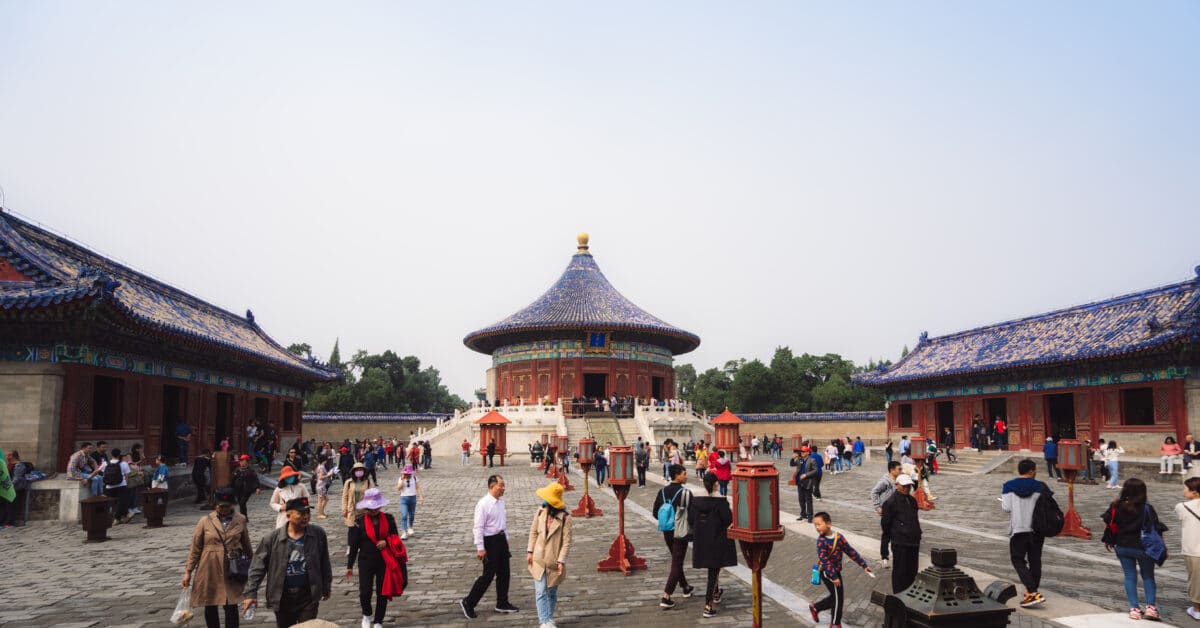
Alipay and UnionPay
Digital payment methods. You will see these everywhere and while they may offer swipeable and QR code payment convenience, unless you’re in China for an extended period, I would just skip them. Both require a Chinese bank account and Chinese phone number to set up. See? Not worth it.
Virtual Private Network (VPN)
It depends on your cellular service provider but if you haven’t heard of it, China has what’s known as the Great Firewall of China. They use this to censor the internet from their citizens. You can get around this by using a VPN which reroutes your internet traffic to bypass the firewall.
Without a VPN you will be unable to access websites like Facebook, Instagram, or the Google web browser. Install it before arriving in the country because you may have some trouble with the App Store as well.
A VPN isn’t outright illegal to have on your phone but it is a sort of grey area as the Chinese government realizes that companies need them to do business with foreign countries.
I use Google Fi as my cellular provider so I had open access to the internet without needing a VPN. I only ran into problems when I connected to WiFi.
DiDi
Uber does not exist in China. They do however have a different App known as DiDi. On the Android App store it’s called DiDi – Greater China.
It functions the same as Uber and allows the driver to call you for verification. I was unable to get it to work because the phone number verification never went through. Others couldn’t even get it to download from the App Store so you’ll want to install and set it up before you get to the country.
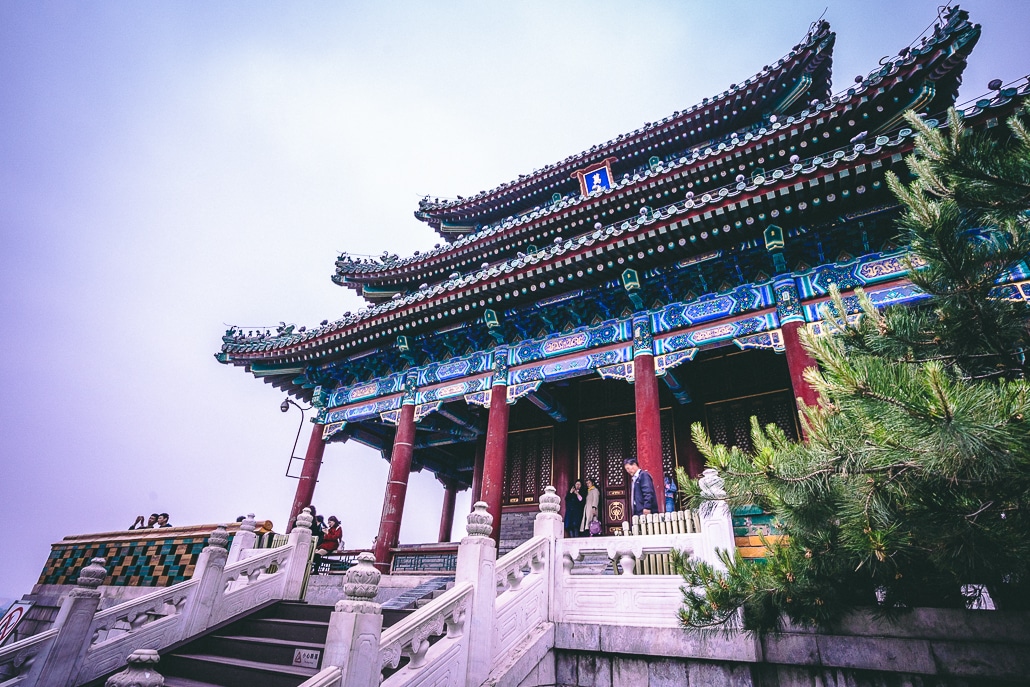
Where NOT to Stay
In Beijing, budget means budget. Spend a few extra dollars for a better place.
I stayed in Leo Hostel Beijing and it was horrendous. I’m not even going to link it. This hostel has taken over as the worst place I’ve ever stayed in.
Here you’ll be sleeping on a hard pallet in a small stuffy room with nonfunctional air-conditioning and no ventilation/opening windows.
If you need to go to the bathroom you’ll have to go all the way down to the first floor and walk through the common areas. This was a very long walk to get to a bathroom.
The worst was the showers.
Their showers are right in the hallway. Literally. You’ll be in the hallway and there’s a shower curtain right there. Are you following what I’m saying? You step directly out of the shower and into a high-traffic hallway.
Inside there isn’t enough space to keep your clothes from getting wet. No bench and no hooks to hang anything on either.
I never did figure out how people were drying off and getting dressed in there. Couple this with the sanitation and you have a hallway shower that smells like a festering toilet. The drain had a mass of hair climbing out of it. A dead cat perhaps? I wouldn’t be surprised.
The rooms have no lockers and you aren’t permitted to have your own outside food in the common areas. So don’t plan on cooking anything for yourself.
I got out of there after one night.
Don’t trust the ratings
Like with cheap knockoff products on Amazon, do not be fooled by the ratings on HostelWorld (8.1 Fabulous) or booking.com (7.9 Good) These ratings are artificially inflated. If it happened here, I’d expect other ratings to be inaccurate as well. All you need to do is walk beyond the front desk to see that its rating is closer to a 1 or a 2.
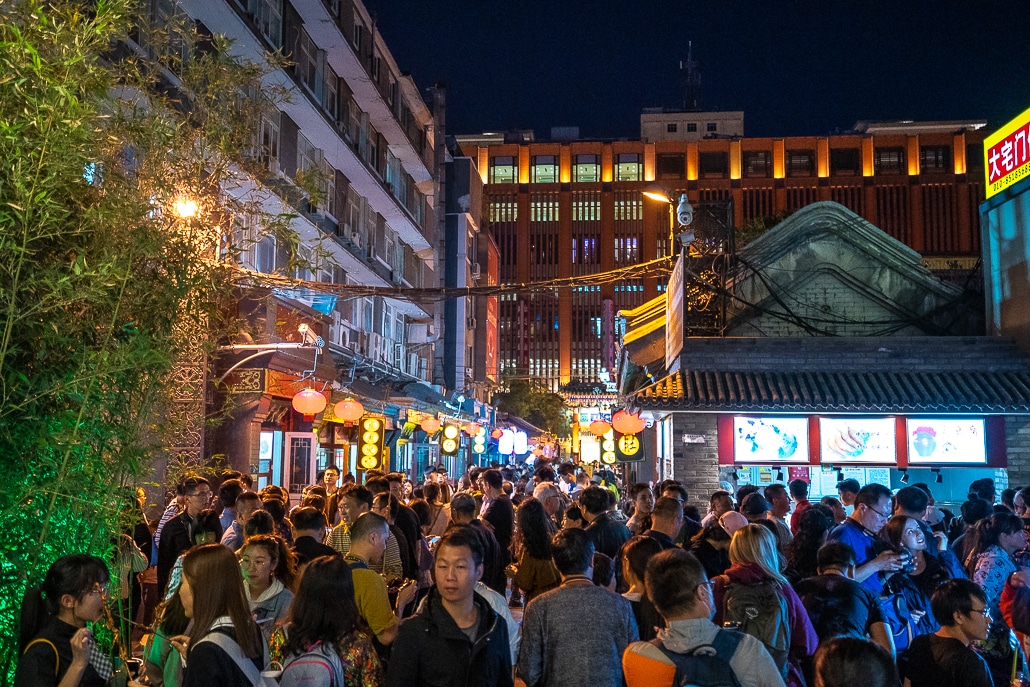
Any other questions about things to do in Beijing? Ask below! And don’t forget to share!
DID YOU ENJOY THIS ARTICLE? PIN IT!
